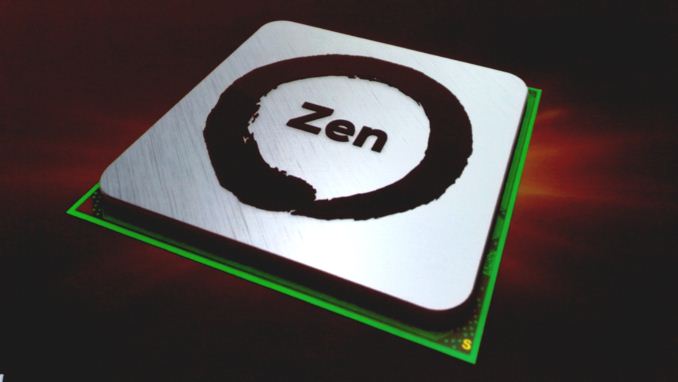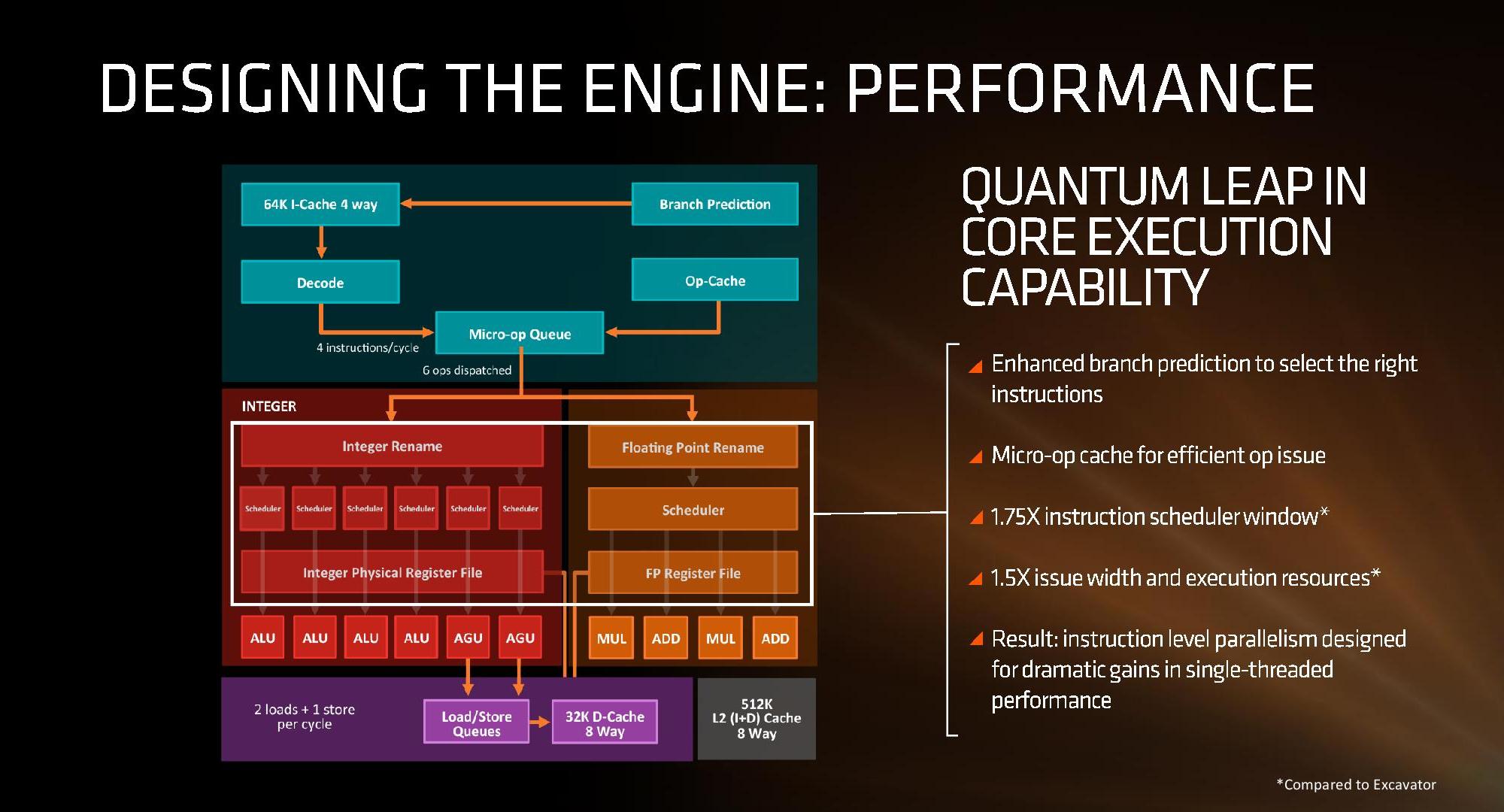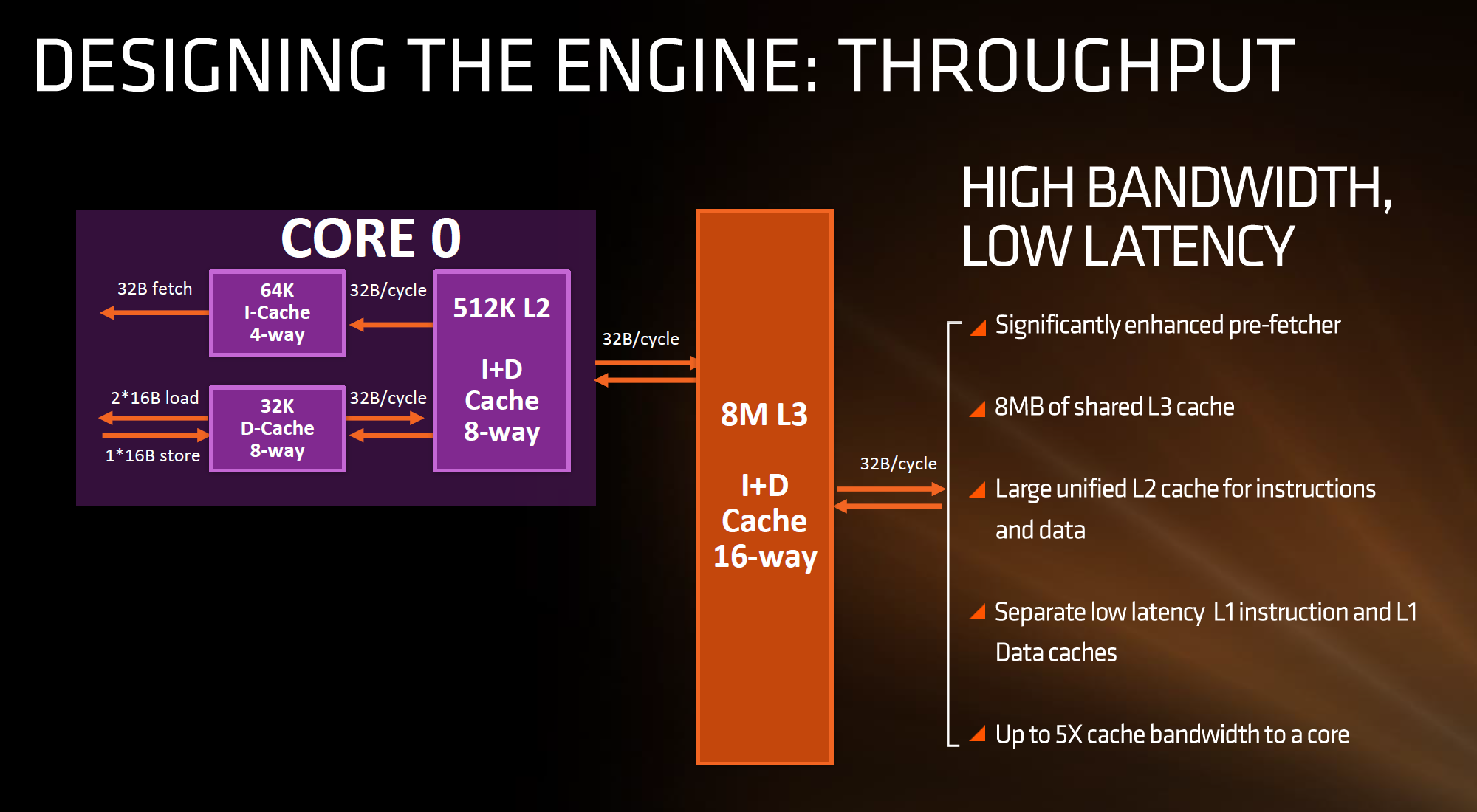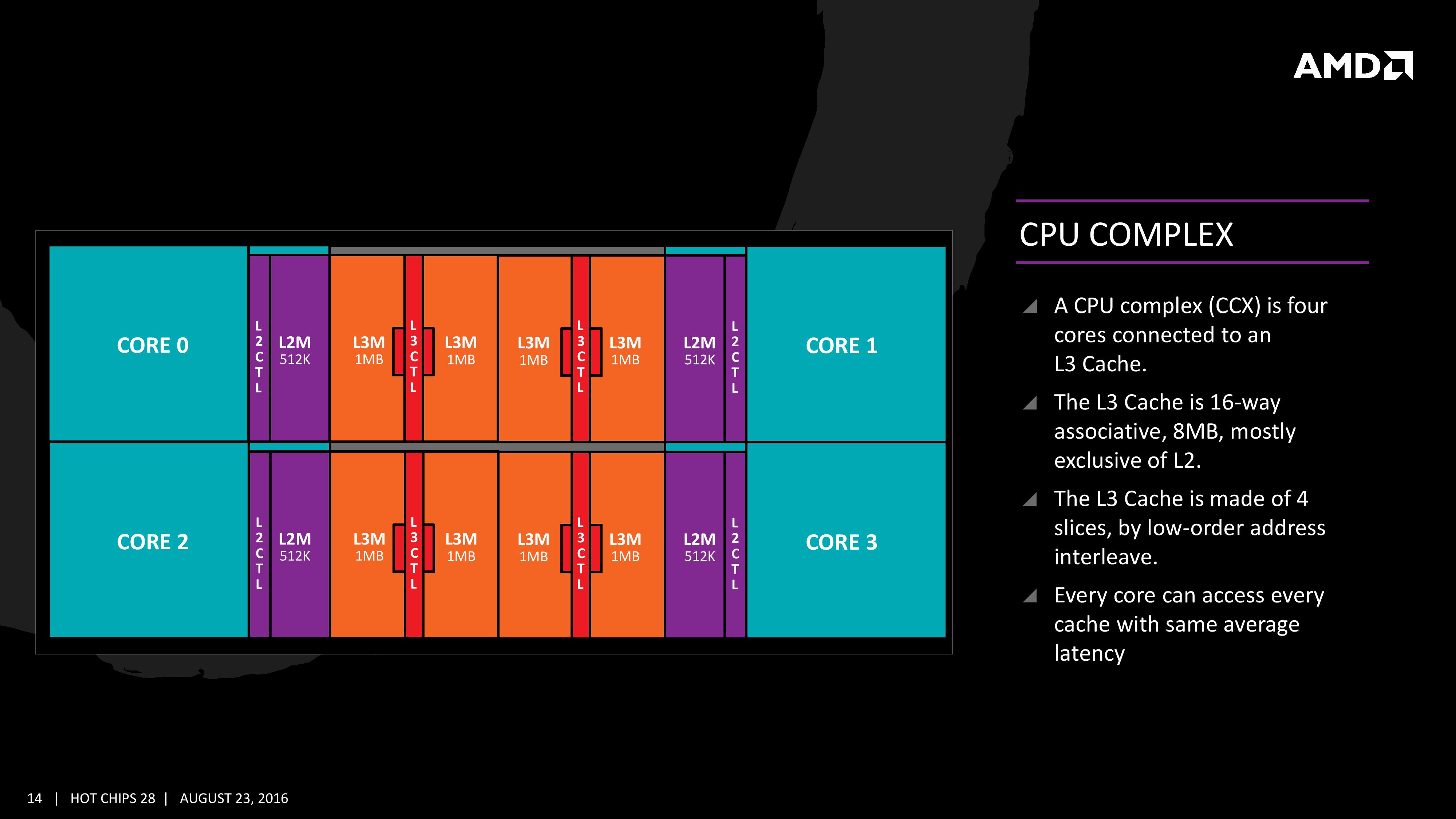AMD Zen Microarchiture Part 2: Extracting Instruction-Level Parallelism
by Ian Cutress on August 23, 2016 8:45 PM EST- Posted in
- CPUs
- AMD
- x86
- Zen
- Microarchitecture

Hot Chips is an annual conference that allows semiconductor companies to present their latest and greatest ideas or forthcoming products in an academic-style environment, and is predominantly aimed as the professional semiconductor engineer. This year has a number of talks about power management, upcoming IBM CPUs, upcoming Intel CPUs, upcoming NVIDIA SoCs and the final talk of the final day is from AMD, discussing Zen in even more depth than the previous week. While we were unable to attend the event in person, we managed to get some hands on time with information and put questions to Mike Clark, AMD Senior Fellow and design engineer.
What We Learned Last Week: L1/L2/L3 Caches and the Micro-Op Buffer
In AMD’s initial presentation for the general media, we were given a sense of the microarchitecture layout. We covered the material, but it contained a number of highlights.
AMD Zen Microarchitecture: Dual Schedulers, Micro-op Cache and Memory Hierarchy Revealed
AMD Server CPUs and Motherboard Analysis
Unpacking AMD's Zen Benchmark: Is Zen actually 2% Faster than Broadwell?
First up, and the most important, was the announcement of the inclusion of a micro-op cache. This allows for instructions that are frequently used to be closer to the micro-op queue and saves a trip through the core and caches to load the desired information. Typically micro-op caches are still relatively small, and while AMD isn’t giving any information for size and accessibility, we know that Intel’s version can support 1536 uOps with 8-way associativity; we expect AMD’s to be similar though there are many options in play.
Secondly is the cache structure. We were given details for the L1, L2 and L3 cache sizes, along with associativity, to compare it to former microarchitectures as well as Intel’s offering.
| CPU Cache Comparison | |||||
| Zen HEDT |
Bulldozer HEDT |
Excavator |
Skylake | Broadwell HEDT |
|
| L1-I | 64KB/core | 64KB/module | 96KB/module | 32KB/core | 32KB/core |
| 4-way | 2-way | 3-way | 8-way | 8-way | |
| L1-D | 32KB/core | 16KB/thread | 32KB/thread | 32KB/core | 32KB/core |
| 8-way | 4-way | 8-way | 8-way | 8-way | |
| L2 | 512KB/core | 1MB/thread | 512KB/thread | 256KB/core | 256KB/core |
| 8-way | 16-way | 16-way | 4-way | 8-way | |
| L3 | 2MB/core | 1MB/thread | - | >2MB/core | 1.5-3MB/core |
| 16-way | 64-way | - | 16-way | 16/20-way | |
| L3 Type | Victim | Victim | - | Write-back | Write-back |
In this case, AMD has given Zen a 64KB L1 Instruction cache per core with 4-way associativity, with a lop-sided 32KB L1 Data cache per core with 8-way associativity. The size and accessibility determines how frequently a cache line is missed, and it is typically a trade-off for die area and power (larger caches require more die area, more associativity usually costs power). The instruction cache, per cycle, can afford a 32byte fetch while the data cache allows for 2x 16-byte loads and one 16-byte store per cycle. AMD stated that allowing two D-cache loads per cycle is more representative of the most workloads that end up with more loads than stores.
The L2 is a large 512 KB, 8-way cache per core. This is double the size of Intel’s 256 KB 4-way cache in Skylake or 256 KB 8-way cache in Broadwell. Typically doubling the cache size affords a 1.414 (square root of 2) better chance of a cache hit, reducing the need to go further out to find data, but comes at the expense of die area. This will have a big impact on a lot of performance metrics, and AMD is promoting faster cache-to-cache transfers than previous generations. Both the L1 and L2 caches are write-back caches, improving over the L1 write-through cache in Bulldozer.
The L3 cache is an 8MB 16-way cache, although at the time last week it was not specified over how many cores this was. From the data release today, we can confirm rumors that this 8 MB cache is split over a four-core module, affording 2 MB of L3 cache per core or 16 MB of L3 cache for the whole 8-core Zen CPU. These two 8 MB caches are separate, so act as a last-level cache per 4-core module with the appropriate hooks into the other L3 to determine if data is needed. As part of the talk today we also learned that the L3 is a pure victim cache for L1/L2 victims, rather than a cache for prefetch/demand data, which tempers the expectations a little but the large L2 will make up for this. We’ll discuss it as part of today’s announcement.
The mid-week release also gave insight into the dual schedulers, one for INT and another for FP, which is different to Intel’s joint scheduler/buffer implementation. The talk at Hot Chips goes into detail about how the dispatch and schedulers operate
The New Information
As part of the Hot Chips presentation, AMD is reaffirming its commitment to at least +40% IPC improvement over Excavator. This has specifically been listed as a throughput goal at an equivalent energy per cycle, resulting in an increase in efficiency. Obviously a number of benefits come from moving the 28nm TSMC process to GloFo’s 14nm FinFET process which is used via a Samsung licence. Both the smaller node and FinFET improvements have been well documented so we won’t go over them here, but AMD is stating that Zen is much more than this as a direct improvement to immediate performance, not just efficiency. While Zen is initially a high-performance x86 core at heart, it is designed to scale all the way from notebooks to supercomputers, or from where the Cat cores (such as Jaguar and Puma) were all the way up to the old Opterons and beyond, all with at least +40% IPC.
The first immediate image out of the presentation is the CPU Complex (a CCX), which shows the Zen core design as a four-CPU cluster with caches. This shows the L2/L3 cache breakdown, and also confirms 2MB of L3 per core with 8 MB of L3 per CCX. It also states that the L3 is mostly exclusive of the L2 cache, which stems from the L3 cache as a victim cache for L2 data. AMD is stating that the protocols involved in the L3 cache design allow each core to access the L3 of each other core with an average (but a range) of latencies.
Over the next few pages, we’ll go through the slides. They detail more information about the application of Simultaneous Multithreading (SMT), New Instructions, the size of various queues and buffers, the back-end of the design, the front-end of the design, fetch, decode, execute, load/store and retire segments.














106 Comments
View All Comments
CrazyElf - Tuesday, August 23, 2016 - link
If they can really get a 40% improvement over Excavator, and I mean 40% on average, not on a few select benchmarks, then AMD has a serious chance of being a compelling option once again.I'm hoping to see more improvements on Floating Point, which was comically bad in Bulldozer.
A big part of the problem is that we don't know how well Zen will clock or the power consumption. Still, this should be a major leap in performance overall. We'll have to wait for the launch day benchmarks to see the true story.
Another big concern is the platform. CPU performance is only part of the story. We need a good platform that can rival the Z170 and Intel HEDT platforms for this to be compelling on the desktop. For mobile, there will have to be good dual channel Zen APUs (Carrizo, as Anandtech noted was heavily gimped by poor quality OEM designs obsessed with cost cutting).
jabber - Wednesday, August 24, 2016 - link
Yeah I don't think OEMs and others are that worried about supporting AMD. AMD have withered away so much, making AMD CPU capable gear must have become a very minor part of say ASUS/Gigabyte/MSI etc. revenue stream. Making AMD based graphics cards is okay but motherboards? Not so much.teuast - Wednesday, August 24, 2016 - link
I wouldn't speak so soon. Just this year MSI and Gigabyte (at least) have introduced new AM3+ boards with USB 3.1 and PCIe 3.0. Why, I'm not sure, but if they're doing that for something as old and deprecated as the FX chips, it would defy logic for Zen to come out and for them to only release a few token efforts.I will say, if the CPUs are good but you're right about OEMs not being concerned with support, then the first OEM to say "hey, why don't we make some actually good AM4 boards?" is going to make an absolute killing.
h4rm0ny - Thursday, August 25, 2016 - link
Are you sure about the PCI-E v3 on AM3+ motherboards? I can find recent releases that have USB3.1 and M.2, but none that support PCI-Ev3. Can you link me or provide a model number? I didn't think 3rd generation PCI-E was possible on the Bulldozer line.SKD007 - Thursday, August 25, 2016 - link
SABERTOOTH 990FX/GEN3 R2.0SKD007 - Thursday, August 25, 2016 - link
https://www.asus.com/Motherboards/SABERTOOTH_990FX...Outlander_04 - Thursday, August 25, 2016 - link
A little misleading . The Graphics pci-e controller is built in to an FX processor so adding a pci-e 3 standard slot to a motherboard will make no difference to actual bandwidth.Not an issue though since x16 pci-e 2 has the same bandwidth as x8 pci-e 3 and intel boards with SLI/crossfire ability running at x8/x8 do not choke any current graphics card
h4rm0ny - Thursday, August 25, 2016 - link
What about PCI-E SSDs? Can I get full bandwidth on those? I agree about the graphics cards but that's not so important to me. If I can get full PCI-Ev3 x4 performance for an SSD then I'll pribably buy this as a hold-over until Zen. Thanks fir the link!fanofanand - Friday, August 26, 2016 - link
Pci-e 3.0 x4 should be the same as 2.0 x 8. So long as you have a vacant x8 it should theoretically work the same.extide - Wednesday, September 7, 2016 - link
I think they use a PLX chip and turn the 32 2.0 lanes from the FX chip into 16 3.0 lanes.